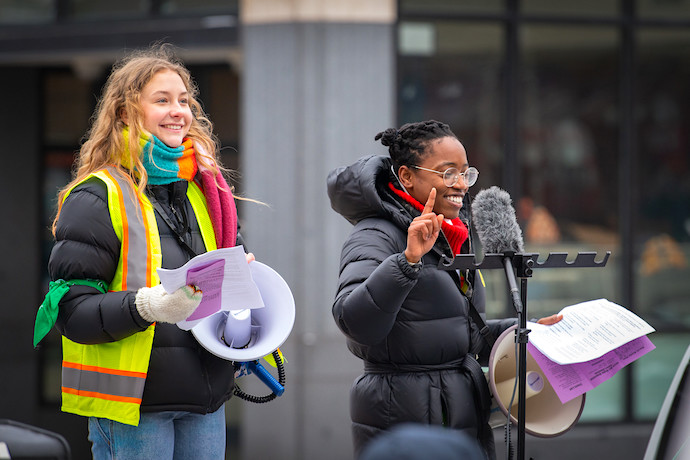“Sometimes I’m irrationally mad at younger women,” wrote the acclaimed television critic and Pulitzer Prize winning writer Emily Nussbaum last week in a now deleted-tweet. The reason for the 57-year-old critic’s anger: “I think they didn’t take abortion rights seriously, didn’t make them a priority…”

The pile-on of angry responses to Nussbaum’s tweet was predictable. Thinking out loud—never mind getting it wrong—on Twitter is risky, especially when you have a high-profile account. Doing so in the wake of Dobbs, when the Supreme Court ripped away a constitutionally protected right to reproductive autonomy, was incendiary.
The anger—both Nussbaum’s and her interlocutors’—is more than understandable. Less than a year after the fall of Roe v Wade, vast stretches of the United States have become reproductive healthcare deserts. The new restrictions in a number of states have produced predictable horror stories: pre-teen rape survivors forced to travel for abortion healthcare; mothers with wanted pregnancies gone wrong forced to carry unviable fetuses to term; patients with dangerous pregnancies pushed to death’s door because physicians are forced to defer to hospital lawyers rather than their own medical judgment. These cruel cases are the visible peaks of a terrible terrain where medical scarcity, clinic closure, and an escalating assault on abortion rights are the new normal.
For supporters of reproductive rights, for countless patients, and for the many activists who continue to fight for reproductive justice, frustration and exhaustion abound. Nussbaum’s tweet represents a predictable and understandable impulse to lash out at those closest to us in response to a calamity. But this impulse is not particularly helpful for understanding what has happened to us. To that end, I want to use Nussbaum’s tweet to invite a historically informed conversation about how we think about the fall of Roe less than a year out from the Dobbs decision.
Let’s get a few things out of the way first: A generation gap did not cause Roe to fall. The reproductive justice movements before and after 1973 have consistently been cross-generational. Pictures of the March for Women’s Lives, from the 1980s onward are documentary evidence of the cross-generational character of the reproductive rights movements. These organized demonstrations were some of the popular expressions of a broader multigenerational movement that has volunteered at clinics, stuffed envelopes to raise funds for reproductive rights organizations large and small, written op-eds, elected politicians, run for office, created abortion travel funds, and so very much more. To suggest that the apathy of young people was somehow responsible for or contributed to the Supreme Court’s Dobbs decision is akin to blaming resource-strapped fire departments for the work of well-organized and well-funded serial-arsonists.
The story of Dobbs isn’t a story of apathy. It’s a story of a broad, multi-generational coalition defending abortion access for half a century against a sustained and multi-pronged sectarian assault on reproductive freedom. Journalists and historians have sketched the broad outlines of this sustained attack, which has ranged from quotidian sidewalk pickets to drives to amend the U.S. constitution with a Human Life Amendment.
But those with the luxury of distance from these sites seldom appreciate what it means to be bombarded day in and day out by graphic signs and aggressive, megaphone-amplified shouts from those who compare abortion to the Holocaust. It bears remembering that Catholic and evangelical churches and organizations haven’t merely condoned but often coordinated these activities for decades.
These demonstrations—which are their own kind of violence—have been ongoing. And they’ve coincided with clinic invasions, arsons and bombings, and the attacks on and the murder of abortion providers and staff. As historian Karissa Haugenberg has documented, religious anti-abortion activists have swarmed abortion clinics, attacked providers, intimidated patients, and destroyed medical equipment.
Since 1977, according to a 2022 report issued by the National Abortion Federation, there have been 11 murders, 42 bombings, 196 cases of arson, and 491 assaults directed at abortion providers and clinics. These numbers do not include the incidents of stalking, bomb threats, and death threats that providers have faced for decades. While some clinics have become walled encampments, these barricades have been thin prophylactics against relentless anti-abortion intimidation, terrorism, and legislation.
Because the Republican Party and anti-abortion organizations have been locked in an ever tighter fetal embrace since 1972, the sustained attack on abortion rights and access has been politically driven and state sponsored. In a country without socialized medicine, the Hyde Amendment (which was just one of many deep cuts to public funds for abortion healthcare) was particularly effective. Public hospitals, private insurance plans, and state level Medicaid plans have also been effectively targeted.
Burdensome regulations dreamed up by anti-abortion activists and enacted by anti-abortion politicians have attempted to stymie abortion seekers while conveying to them the sectarian notion that a fetus is a child and abortion is murder. These roadblocks have included mandatory waiting periods, invasive ultrasounds (including transvaginal ultrasounds), mandatory counseling from anti-abortion representatives, and mandatory fetal cremation or burial. These and so much more have impacted abortion seekers and providers since Roe.
This above inventory of the armaments used in the multi-decade war on abortion rights in the United States is woefully incomplete. It doesn’t do justice to the history of the conservative legal movement and its efforts to cultivate lawyers and stack courts with anti-abortion judges. Nor does it speak to how the current composition of the conservative Supreme Court came to be. It doesn’t address the ongoing social and economic pressures placed upon abortion clinics and those businesses that provide necessary services to them, such as medical waste disposal. And it doesn’t engage with the anti-abortion movement’s ongoing production of bunk science that scaffolds many of its policy initiatives.
All of which is to say that, for decades, abortion providers, abortion seekers, and those who’ve supported them have been barraged with all of the above and so much more. If you support reproductive autonomy and a right to abortion access, there is much to be angry about. There has been so much to be angry about for such a long time. But our current predicament is certainly not the fault of younger people and their lack of seriousness. That would be far easier to address than the vast cultural, religious and political efforts to overturn Roe and how abortion has been an engine powering broader anti-democratic forces in the United States.





